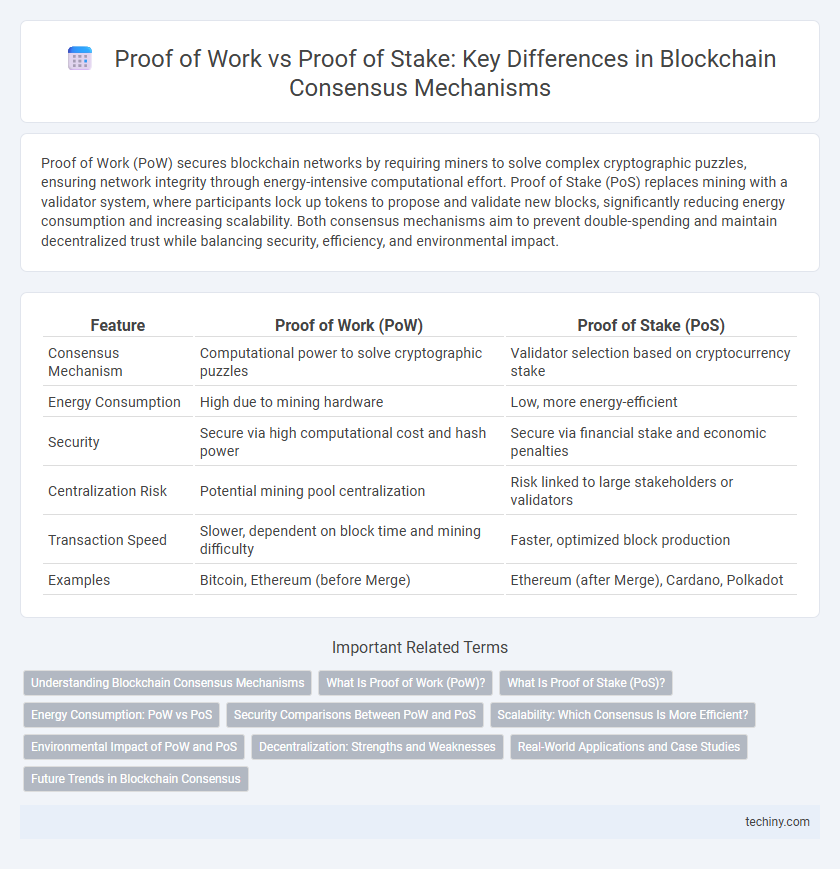Proof of Work (PoW) secures blockchain networks by requiring miners to solve complex cryptographic puzzles, ensuring network integrity through energy-intensive computational effort. Proof of Stake (PoS) replaces mining with a validator system, where participants lock up tokens to propose and validate new blocks, significantly reducing energy consumption and increasing scalability. Both consensus mechanisms aim to prevent double-spending and maintain decentralized trust while balancing security, efficiency, and environmental impact.
Table of Comparison
| Feature | Proof of Work (PoW) | Proof of Stake (PoS) |
|---|---|---|
| Consensus Mechanism | Computational power to solve cryptographic puzzles | Validator selection based on cryptocurrency stake |
| Energy Consumption | High due to mining hardware | Low, more energy-efficient |
| Security | Secure via high computational cost and hash power | Secure via financial stake and economic penalties |
| Centralization Risk | Potential mining pool centralization | Risk linked to large stakeholders or validators |
| Transaction Speed | Slower, dependent on block time and mining difficulty | Faster, optimized block production |
| Examples | Bitcoin, Ethereum (before Merge) | Ethereum (after Merge), Cardano, Polkadot |
Understanding Blockchain Consensus Mechanisms
Proof of Work (PoW) relies on miners solving complex cryptographic puzzles to validate transactions and secure the blockchain, consuming significant computational power and energy. Proof of Stake (PoS) selects validators based on the number of tokens they hold and are willing to "stake," enhancing energy efficiency and scalability. Both mechanisms ensure network security and consensus but differ fundamentally in resource usage and attack resistance.
What Is Proof of Work (PoW)?
Proof of Work (PoW) is a consensus mechanism used in blockchain networks like Bitcoin to validate transactions and secure the network by solving complex mathematical puzzles. Miners compete to solve these cryptographic challenges, requiring significant computational power and energy consumption. PoW ensures decentralization and security by making it difficult and costly to manipulate the blockchain ledger.
What Is Proof of Stake (PoS)?
Proof of Stake (PoS) is a consensus mechanism used in blockchain networks where validators are chosen to create new blocks based on the number of coins they hold and are willing to "stake" as collateral. Unlike Proof of Work (PoW), PoS significantly reduces energy consumption by eliminating the need for solving complex cryptographic puzzles. This method enhances network scalability and security by incentivizing validators to act honestly, as malicious actions could result in losing their staked assets.
Energy Consumption: PoW vs PoS
Proof of Work (PoW) requires miners to solve complex mathematical puzzles, consuming vast amounts of energy due to intensive computational power, often comparable to small countries' electricity usage. In contrast, Proof of Stake (PoS) drastically reduces energy consumption by selecting validators based on the number of tokens they hold and are willing to "stake" as collateral, eliminating the need for energy-intensive calculations. This shift from PoW to PoS is central to blockchain sustainability efforts, significantly lowering carbon footprints and operational costs.
Security Comparisons Between PoW and PoS
Proof of Work (PoW) secures blockchain networks by requiring miners to solve complex cryptographic puzzles, making attacks computationally expensive and energy-intensive. Proof of Stake (PoS) relies on validators who stake cryptocurrency as collateral, incentivizing honest behavior since malicious actions result in financial loss of staked assets. PoW offers strong protection against double-spending through resource-based security, while PoS enhances defense by aligning economic incentives with network integrity, reducing vulnerability to 51% attacks if a majority stake is controlled.
Scalability: Which Consensus Is More Efficient?
Proof of Stake (PoS) offers greater scalability compared to Proof of Work (PoW) by significantly reducing the energy consumption and computational power required for network validation. PoW's reliance on mining with high-performance hardware creates bottlenecks that limit transaction throughput and increase latency. PoS leverages validators who are chosen based on stake rather than computational work, enabling faster block times and enhanced scalability for blockchain networks.
Environmental Impact of PoW and PoS
Proof of Work (PoW) consumes vast amounts of electricity due to intense computational mining processes, contributing significantly to carbon emissions and environmental degradation. In contrast, Proof of Stake (PoS) drastically reduces energy consumption by eliminating the need for energy-intensive mining, relying instead on validators who are chosen based on the number of tokens they hold and stake. Transitioning to PoS can lower the blockchain network's carbon footprint by over 99%, promoting sustainable and eco-friendly cryptocurrency operations.
Decentralization: Strengths and Weaknesses
Proof of Work (PoW) enhances decentralization by allowing anyone with mining hardware to participate, fostering a broad distribution of network control, but its high energy consumption and specialized equipment requirements can centralize mining power among large operators. Proof of Stake (PoS) reduces energy use and lowers entry barriers by enabling validators to secure the network based on coin ownership, yet it risks centralization as wealthier participants accumulate more influence over block validation. While PoW emphasizes security through computational effort, PoS offers scalability with potential trade-offs in decentralization depending on stake distribution.
Real-World Applications and Case Studies
Proof of Work (PoW) powers Bitcoin, ensuring security through computational effort, while Proof of Stake (PoS) underpins Ethereum 2.0, offering scalability and energy efficiency. In real-world applications, PoW excels in immutable transaction validation, crucial for financial systems, whereas PoS supports decentralized finance (DeFi) projects by enabling faster and cost-effective consensus. Case studies reveal Bitcoin's dominance in secure value transfer, contrasted with PoS-based networks like Cardano driving smart contract adoption and large-scale decentralized applications.
Future Trends in Blockchain Consensus
Proof of Stake (PoS) is rapidly gaining adoption due to its energy efficiency and scalability advantages over Proof of Work (PoW), making it the preferred consensus mechanism for many upcoming blockchain projects. Emerging innovations like Verifiable Delay Functions (VDFs) and hybrid consensus models combine the security elements of PoW with the sustainability of PoS to address future scalability and decentralization challenges. Industry trends emphasize Layer 2 solutions and sharding to further enhance transaction throughput without compromising network security in next-generation blockchain ecosystems.
Proof of Work vs Proof of Stake Infographic

 techiny.com
techiny.com